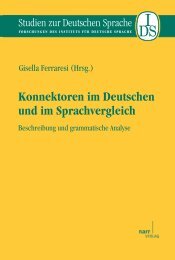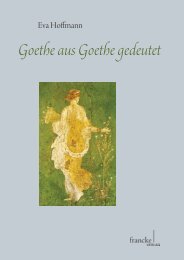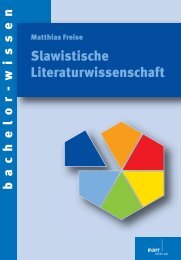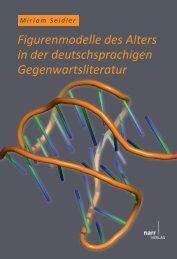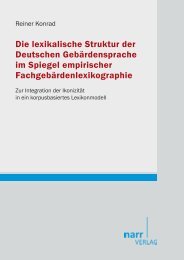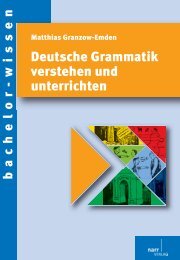Phraseologie. global - areal - regional - im Shop von Narr Francke ...
Phraseologie. global - areal - regional - im Shop von Narr Francke ...
Phraseologie. global - areal - regional - im Shop von Narr Francke ...
You also want an ePaper? Increase the reach of your titles
YUMPU automatically turns print PDFs into web optimized ePapers that Google loves.
16<br />
Elisabeth Piirainen<br />
two or three languages per unit that are separated from other languages by clear boundaries, without<br />
regard to the whole. This can be illustrated with a very recent example, cited here only as one<br />
example of many s<strong>im</strong>ilar studies.<br />
In a conference volume that was recently published (Álvarez de la Granja 2008), there are 19<br />
contributions from the field of cross-linguistic, mainly bilingual, phraseology. There are several<br />
cases where one and the same idiom is discussed in different articles of the book, without reference<br />
to one another. For example, an article on Latvian and French proverbs (Billere 2008, 256)<br />
finds that both languages reveal the same attitude towards a man’s work: “Quand il s’agit de<br />
l’attitude des gens envers le travail, les français aussi bien que les lettons associent le travail au<br />
pain”, citing the French idiom manger son pain à la sueur de son front “to eat one’s bread by the<br />
sweat of one’s forehead”. The biblical origin of the idiom (Genesis 3:19) or the linguistic situation<br />
in languages other than Latvian and French, however, play no role.<br />
The same idiom is the topic of a trilingual study in the above-mentioned volume (Ayupova<br />
2008, 51), which observes that “[w]hen a Russian works very hard his face sweats ( –<br />
with sweat in one’s face), whereas sweat will on the Englishman’s brow (the sweat of one’s brow)<br />
and the Tatar’s forehead ( – with sweat on the forehead).” The author comes<br />
to the conclusion that “[s]uch differences in the componential structure of interlingual phraseological<br />
equivalents cannot be due to any other factor than people’s differing mentalities, linguistic<br />
<strong>im</strong>ages of the world, or the associations speakers of these languages make.” (ibid.) Again,<br />
instead of a consideration of the cultural and historical background – the fact that the lexical differences<br />
between face, brow and forehead are due to different biblical traditions, i. e. to different<br />
translations of one and the same verse from the Bible – unsound explanations are made based on<br />
“people’s differing mentalities”.<br />
Such examples show that phraseological research has to get away from accidental observations<br />
on “s<strong>im</strong>ilarities” or “differences” of idioms in a few languages and instead study the phenomena<br />
across as many languages as possible. Above all, phraseology is a linguistic level that – due to its<br />
interrelation with culture – can be better explored and understood in a pan-European context. An<br />
inventory of idioms that shows equivalents across many languages, be it in the form of a reference<br />
book or otherwise, is a matter of urgent necessity in order to provide researchers with information<br />
that goes beyond only a few languages.<br />
As only a large-scale investigation can reveal, more than 52 European languages have adopted<br />
equivalents of the idiom by the sweat of one’s brow (or German <strong>im</strong> Schweiße seines Angesichts<br />
“by the sweat of one’s face”, Spanish con el sudor de su frente “with the sweat of his forehead”,<br />
etc.). Map 1 illustrates the diffusion of the idiom: Languages marked on gray rectangles possess<br />
equivalents. Certain regularities can be discovered with respect to the different constituents: All<br />
Romance languages, as well as Albanian, Greek and North Finnic languages have the variant with<br />
forehead, all Germanic languages (except for English), the Baltic languages, Hungarian and Maltese<br />
have the variant face, while the Sla<strong>von</strong>ic languages vary between the two or use them side by<br />
side (e. g. Macedonian vo potta na svoeto lice/elo “in the sweat of his face/forehead”). The<br />
variant brow is restricted to English, Irish (as allas a mhalai/le hallas a mhalaí “by the sweat of<br />
his brow”) and West Kara<strong>im</strong>, a very small declining Turkic language (manlajynyn terinia kadar<br />
(išliamia) “(to work) till the sweat on one’s brow”). Other Turkic languages (Turkish, Tatar and<br />
Azerbaijani) follow the pattern forehead. A variant “with sweat on one’s cheek” is known in Latvian<br />
(ar sviedriem vaig). Map 1 is among the early results that emerged in the context of the<br />
project “Widespread Idioms in Europe and Beyond”, which will be briefly outlined below.





